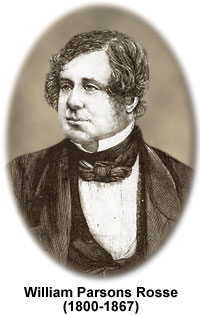William Parsons Rosse
(1800-1867)

Born William Parsons, Rosse was known as Lord Oxmantown before he became the third Earl of Rosse upon the death of his father in 1841. He served in a variety of political positions and was an avid astronomer. Rosse is most famous for his construction of the largest and most powerful reflecting telescope in the Victorian period, which was frequently referred to as the Leviathan.
Rosse's status as the eldest son of a titled landowner ensured him a prestigious education, and he was schooled at Trinity College in Ireland and Oxford University in England. In 1821, he became a member of the House of Commons and later served as an Irish peer in the House of Lords. He was also a member of the Royal Society and acted as its president from 1849 to 1854. Despite such prestigious positions, however, Rosse's passion was astronomy and he began a quest to improve the reflecting telescope around 1827.
Primarily interested in increasing the size of the telescope in order to achieve new observational capabilities, Rosse began by considering how to construct an unusually large mirror. The process of finding a suitable alloy took years to complete and then additional experimentation was undertaken to perfect the process of casting and cooling. His initial efforts involved mirrors only 36 inches in diameter, but by 1842 he was ready to begin work on a mirror twice that size.
Three years later, in 1845, Rosse's gargantuan telescope was complete. The mirror that he had spent so much time creating weighed almost four-tons and was 72 inches in diameter. It was installed in a wooden tube that was 57 feet long, and two large walls encased the structure in order to prevent the wind from disturbing its position. Though it was located on his estate in Birr, Ireland, also known as Parsonstown, Rosse did not begin heavily using the instrument until 1848. The Leviathan's tremendous resolving power enabled Rosse, who was principally interested in nebulae, to make a number of astronomical discoveries and attracted scientists from around the world.
On October 31, 1867, Rosse passed away, but his massive telescope continued to be used by other astronomers for many years. It remained the world's largest telescope for almost 75 years and continued as the most powerful in terms of resolution for an even longer period of time. Dismantled in the early twentieth century, Rosse's telescope was restored in 1997 and is now part of a historic science center located at Birr.
